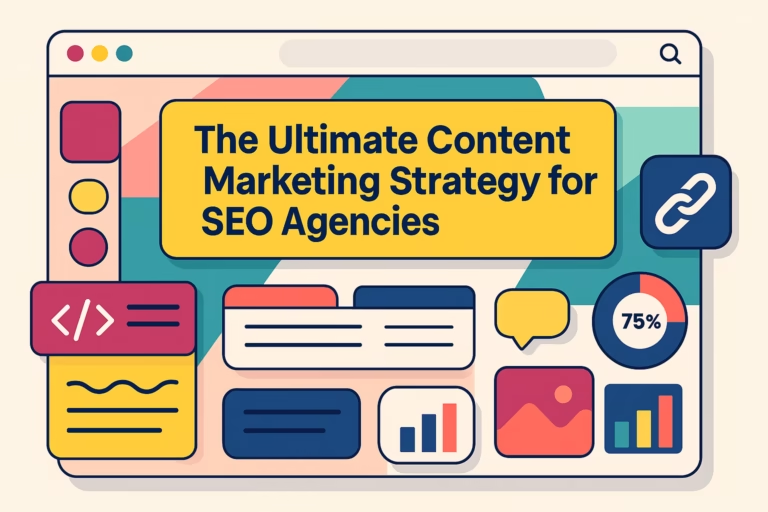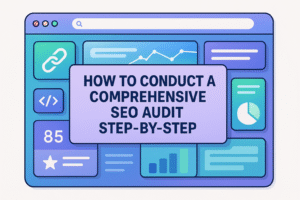In today’s competitive digital arena, SEO agencies must leverage a powerful content marketing strategy tailored specifically to their needs. This is the key to capturing attention and showcasing expertise. By precisely crafting and delivering content, agencies can elevate their search rankings, establish authority, and enhance profitability.
Content marketing extends beyond mere content creation; it involves a strategic alignment with defined goals and audience expectations. Success for SEO agencies hinges on understanding these nuances—setting clear objectives, creating detailed audience personas, conducting thorough content audits, and selecting optimal distribution channels. Each component is critical in crafting a strategy that distinguishes an agency from its competitors.
This guide provides comprehensive insights into mastering content marketing for SEO agencies. Discover how to build effective content clusters, seamlessly integrate marketing funnels, and utilize powerful analytics frameworks. Develop a strategy that not only boosts online visibility and strengthens brand trust but also addresses common challenges, optimizes resources, and drives measurable outcomes.
Understanding Content Marketing for SEO Agencies
Content marketing plays a pivotal role in attracting, engaging, and influencing purchasing decisions for target audiences. For SEO agencies, building a successful content marketing strategy is crucial to enhance brand awareness and generate leads more cost-effectively than traditional outbound marketing. Notably, content marketing is reported to cost 62% less and yield more than three times the leads compared to outbound methods.
Diversifying content formats is essential. Agencies should incorporate blog posts, videos, podcasts, and infographics to maintain audience interest across various platforms. Delivering valuable and relevant content consistently helps in building trust and establishing the agency as a thought leader in the industry.
Utilizing storytelling techniques can further enhance content effectiveness by making brand communications memorable and engaging. This approach fosters better customer connections and can positively influence buying decisions.
Here’s a quick checklist for SEO agencies to improve content marketing:
- Diversify Content Formats: Use blogs, videos, podcasts, infographics.
- Ensure Value and Relevance: Regularly provide high-quality content.
- Integrate Storytelling: Enhance engagement and memorability.
- Build Trust and Thought Leadership: Position yourself as an industry expert.
By following these elements, SEO agencies can craft a robust and successful content marketing strategy.
Aligning Team Goals with Content Strategy
Aligning team goals with your content strategy is crucial for creating high-quality content that resonates with your target audience. To achieve this alignment, it’s essential to ensure that every member of your content team understands the overarching objectives of your content marketing efforts.
Start by identifying your content goals, such as increasing brand awareness, generating leads, or enhancing customer engagement. These goals should be aligned with the customer journey and the buyer personas you aim to attract. A clear understanding of these elements helps in crafting valuable content that appeals to potential customers.
A well-structured content plan and calendar play a pivotal role in maintaining alignment. They provide a roadmap for content creation, helping your team produce compelling content consistently across various formats, from blog posts to social media posts and white papers.
Consider conducting a content audit to assess existing materials, ensuring they meet your goals and are optimized for search engines. Regular audits and feedback loops enable your team to refine the content creation process, resulting in an effective content marketing strategy.
By aligning team goals with your content strategy, you can foster collaboration, streamline efforts, and achieve a successful content marketing strategy.
Defining Clear and Achievable Goals
Defining clear and achievable goals is the cornerstone of any successful content marketing strategy. These goals align with broader revenue targets and business objectives, ensuring every piece of content drives measurable performance. Clearly defined goals shape the entire content strategy by determining what you aim to achieve.
Potential Content Marketing Goals:
– Establishing thought leadership
– Increasing search engine traffic
– Improving customer retention
Documenting these goals is crucial. A documented strategy illustrates a correlation between defined objectives and success.
Here’s a simple table showcasing the alignment of goals with business objectives:
| Content Goal | Business Objective |
| Thought Leadership | Brand Authority |
| Search Engine Traffic | Increased Visibility/Leads |
| Customer Retention | Boost in Customer Lifetime Value |
Establishing these goals not only guides your content team but also helps in organizing your content creation process. By setting clear objectives, you can craft a content plan that effectively targets your audience and potential customers, delivering valuable and relevant content.
Ultimately, a solid foundation of well-documented goals ensures your content marketing efforts are both impactful and strategic.
Developing Detailed Audience Personas
Developing detailed audience personas is a crucial aspect of a successful content marketing strategy. Audience personas are semi-fictional representations of ideal customers, crafted from data and research. They guide the content creation process, ensuring content aligns with the needs of potential customers.
Creating these personas involves analyzing a variety of factors, including demographics, psychographics, interests, values, and needs, as well as understanding how the business integrates into customers’ lives. By reflecting on target customers’ specific needs, businesses can create compelling and valuable content that effectively meets those demands.
Furthermore, incorporating insights from sales, marketing, and other business areas into buyer personas enhances their accuracy and usefulness. This collaborative approach provides unique insights about the target audience that are often overlooked in the industry.
Key considerations when creating audience personas:
– Demographic details (age, gender, location)
– Psychographic traits (interests, values, lifestyle)
– Behavioral patterns (buying habits, brand interaction)
– Needs and pain points
– How your business addresses these needs
By leveraging detailed audience personas, organizations can optimize their content marketing efforts, ensuring they reach and resonate with their target audience effectively.
Conducting Comprehensive Content Audits
Conducting comprehensive content audits is crucial for refining your content marketing strategy. A content audit involves analyzing existing content to identify opportunities for improvement and enhance the overall approach. By conducting a data-driven content audit, you can reveal content gaps, outdated assets, and underperforming topics needing refreshment or consolidation. This process also highlights successful content areas that can be expanded, maximizing content marketing efforts.
Utilizing strategic tools like SEMRush’s Content Audit tool can streamline this process. These tools allow you to set up specific audits for sections like blogs, enabling a focused analysis of performance metrics. The insights gained from these audits help you better tailor content to your audience personas and attract qualified prospects.
Benefits of Content Audits
– Identify Content Gaps: Find areas to develop new and compelling content.
– Refresh Outdated Content: Keep your content library current and relevant.
– Expand Successful Content: Enhance well-performing content for broader reach.
– Improve Targeting: Align content better with audience and buyer personas.
Incorporating findings from content audits into your content creation and distribution strategies ensures your content remains valuable and effective across search engines and social media channels.
Selecting the Right Content Types for SEO Agencies
Developing a successful content marketing strategy is essential for SEO agencies aiming to engage their target audience and potential customers. Selecting the right content types is crucial. This involves producing valuable content that not only appeals to buyer personas but also aligns with the agency’s overarching content marketing strategies.
Start by understanding your audience’s preferences through a content audit, then align your content goals with search engine optimization techniques. This can include creating high-quality blog posts and white papers that serve as a central core. These can be repurposed across social media channels, making up diverse content formats.
Consider these types of content:
– Blog Posts: Enhance search engine visibility.
– Social Media Posts: Increase engagement across platforms.
– White Papers: Establish authority and depth.
– Compelling Content: Engage emotionally to build community.
Additionally, integrating user-generated content and frequently evaluating engagement metrics helps refine the content creation process. Analyzing successful competitors’ strategies also offers insights into effective content tactics.
To implement this, construct a content calendar to organize and schedule the content delivery. By focusing on relevant content that informs or entertains, SEO agencies can create connection and trust, resulting in a more effective content marketing effort.
Identifying Effective Content Distribution Channels
Identifying effective content distribution channels is crucial for a successful content marketing strategy. Choosing the right platforms such as social media, email marketing, or your company’s website ensures your content reaches and engages your target audience efficiently. To maintain relevance and build brand loyalty, it’s essential to distribute content consistently across these channels.
Diverse channels play a key role in engaging audiences throughout their customer journey, from initial awareness to fostering long-term loyalty. By leveraging multiple distribution channels, you can guide potential customers through the sales funnel, offering solutions and new insights that resonate with their needs.
Key Content Distribution Channels:
– Social Media Platforms: Engage your audience instantly and share compelling content that encourages interaction.
– Email Marketing: Deliver personalized messages directly to your potential customers’ inboxes.
– Company Website: Serve as a hub for high-quality content that showcases your brand’s expertise.
Strategic use of these channels not only enhances brand awareness and customer engagement but also contributes to increased sales. A well-planned distribution strategy will boost your content marketing efforts, ensuring that your valuable content delivers maximum impact and reaches your desired content goals.
Establishing a Consistent Content Creation Process
Establishing a consistent content creation process is crucial for building trust with your target audience and maintaining brand visibility. A content calendar is vital in this process as it ensures regular content publishing, keeping your brand active in the eyes of potential customers.
To manage and organize content production, productivity tools like Asana or editorial calendar tools like CoSchedule can be highly beneficial. They help streamline the process, making it easier for your content team to adhere to a schedule.
Implementing content governance with clear standards and policies is essential for maintaining consistency and quality in your content. This ensures that all content types, from blog posts to social media content, align with your brand’s voice.
Task management, along with iterative feedback processes, is crucial for refining content strategies. This ongoing analysis allows for the adaptation necessary to meet changing needs.
Here’s a quick checklist to establish your process:
– Create a content calendar.
– Use productivity tools like Asana.
– Set content governance policies.
– Regularly evaluate and refine your strategies.
– Break goals into actionable steps.
By following these steps, you’ll develop a successful content creation process that consistently delivers valuable content to your audience.
Setting Up Measurement and Analytics Frameworks
Implementing an effective content marketing strategy requires careful measurement and analysis to ensure success. Google Analytics is an invaluable tool for gauging the performance of your content marketing strategies. It provides insights into how well your content is attracting and engaging your target audience.
To track social sharing activity, tools like Buzzsumo are highly effective and can reveal which social media channels are driving the most engagement. For conversion analytics, OptinMonster offers valuable metrics to assess the success of your marketing campaigns and the journey of potential customers.
Monitoring the awareness and engagement KPIs of your content can be streamlined with tools such as Google Alerts and Mention. These tools track if your content is being mentioned and shared, providing a gauge of its reach.
Third-party tools like SEMrush and Ahrefs are essential for measuring the impact of specific content marketing efforts, helping to refine your content calendar and guide your content strategy.
Table: Key Tools for Measuring Content Marketing
| Tool | Purpose |
| Google Analytics | Performance measurement |
| Buzzsumo | Social sharing activity tracking |
| OptinMonster | Conversion analytics |
| Google Alerts | Monitoring mentions for engagement |
| SEMrush/Ahrefs | Specific content impact assessment |
Through these tools, your content team can craft a successful and data-driven content marketing strategy.
Leveraging Competitive Research for Strategic Advantage
Leveraging competitive research can be transformative for your content marketing strategy by gaining a strategic advantage. Understanding your competitors’ strategies provides insights into what resonates with your shared target audience. This process helps refine your own approach to delivering valuable content.
Begin by identifying your competitors and conducting a content audit to assess their strengths and weaknesses. Evaluate the types of content they prioritize, like blog posts, social media content, or white papers. Observe their content creation processes and content formats used to engage potential customers. Analyzing their search engine optimization tactics and social media channels can refine your own strategies for reaching customer journey milestones.
Competition analysis also involves monitoring content goals and tracking keyword performance to discover gaps or opportunities in the market. By understanding buyer personas and their journey within competitor frameworks, you can tailor high-quality, relevant content that positions your brand as a thought leader.
A strategic approach to competitive research includes creating a content plan with a content calendar detailing your initiatives. Continually assess performance through measurement and analysis to ensure your content marketing efforts remain efficient and effective, ultimately driving meaningful engagement.
Crafting and Implementing Brand Guidelines
Crafting and implementing brand guidelines is a pivotal step in building a coherent and consistent brand identity. These essential documents encapsulate your brand’s overall look and feel, color palette, typography, personality, and messaging. By defining these elements, brand guidelines provide a solid foundation for content governance, ensuring that all content aligns with the brand’s core values and identity.
Brand guidelines are instrumental in establishing a website’s design language and shaping ad creatives. They foster consistent and cohesive content production across various formats and platforms by detailing style, tone of voice, and quality criteria. This uniformity is crucial for maintaining high-quality content creation, whether by in-house team members or freelancers.
Here’s a brief outline of what brand guidelines typically include:
- Visual Elements
– Logo usage
– Color palette
– Typography - Voice and Tone
– Brand personality
– Messaging style - Quality Standards
– Style rules
– Content examples
By adhering to these guidelines, businesses can ensure consistency and quality in all content marketing efforts, enhancing their ability to connect with their target audience effectively.
Building and Utilizing Content Clusters
Building and utilizing content clusters is an effective strategy to enhance your content marketing efforts. Content clusters, also referred to as topic clusters or content hubs, are interconnected pieces of content centered around a specific topic. This approach not only helps establish brand authority but also targets consumers at various stages of the marketing funnel.
The structure of content clusters typically includes a central post, known as pillar content, which provides a general overview of the topic. Supporting this pillar are cluster pages that delve into related subtopics, creating a comprehensive network of information.
Implementing content clusters streamlines the content ideation process, maintains workflow consistency, and is a vital component of a larger content strategy. This strategy involves key stages: planning, creating, and distributing content effectively.
Benefits of Content Clusters:
– Enhance SEO: Improves ranking on search engines due to structured and organized content.
– Establish Authority: Positions your brand as an expert in the field.
– Targeted Engagement: Attracts and engages potential customers throughout their buyer journey.
By utilizing content clusters, you can produce high-quality, relevant content that resonates with your target audience, ultimately leading to a successful content marketing strategy.
Integrating Marketing Funnels with Content Strategy
Integrating marketing funnels with content strategy is crucial for guiding potential customers from awareness to decision-making. Understanding your target audience’s key pain points and purchase blockers is vital for crafting effective content. A well-structured content marketing funnel addresses these by aligning content with each stage of the buyer’s journey: TOFU (Top of the Funnel), MOFU (Middle of the Funnel), and BOFU (Bottom of the Funnel).
Incorporating insights from sales teams and account managers can significantly enhance content relevance. By doing so, content marketing strategies can better attract and engage audiences, influencing their buying decisions. According to the McKinsey customer journey model, different content types, such as blog posts, white papers, and social media posts, can be used strategically across different stages.
Stages of the Content Marketing Funnel:
| Stage | Focus | Content Examples |
| TOFU | Awareness | Blog posts, Social media content |
| MOFU | Evaluation | White papers, Case studies |
| BOFU | Decision | Testimonials, Product comparisons |
By tailoring content to each funnel stage and using relevant content formats, brands can effectively guide potential customers, ultimately increasing conversions and building lasting relationships.
Optimizing Resource Allocation
Optimizing resource allocation in a content marketing strategy is crucial for maximizing efficiency and achieving a high return on investment (ROI). A fully mapped-out strategy helps in focusing efforts and budgets on activities that yield the best results. Understanding the type of content needed and selecting appropriate platforms for distribution enhance resource allocation effectiveness.
Key steps in this process include:
- Analyzing types of content needed (e.g., blog posts, social media content).
- Mapping out a content calendar for timely execution.
- Defining content goals to align resources with objectives.
- Conducting a content audit to identify gaps and allocate resources strategically.
| Resource Allocation Components | Description |
| Time | Efficient schedule and consistent content delivery. |
| Budget | Investment targeting high-ROI activities. |
| Manpower | Assigning tasks to the right team members. |
Proper resource allocation ensures necessary assets are available where they have the most impact. This strategic approach allows companies to produce and distribute content more efficiently, enhancing overall marketing efforts.
Developing and Using a Content Calendar
A content calendar is a vital tool for organizing, managing, and scheduling content production across multiple platforms. By maintaining a content calendar, you ensure consistent content publishing, which is crucial for keeping your target audience engaged and attracting potential customers.
Benefits of a Content Calendar:
– Ensures consistency and frequency in content publishing.
– Provides a clear content strategy roadmap.
– Helps in planning and executing a diverse range of content types (e.g., blog posts, social media posts, white papers).
Tools to Create a Content Calendar:
– Google Sheets
– Trello
– Asana
– Basecamp
Implementing a workflow in your content calendar helps reduce inconsistencies and allows your content team to track the progress of content marketing campaigns. An editorial calendar facilitates a well-balanced content library, enhancing content marketing efforts across websites and social media channels.
Key Features to Include:
– Content publication dates
– Platforms (e.g., social media, website)
– Content formats and types
By leveraging a content calendar, you can streamline the content creation process, enhance search engine optimization, and ensure the delivery of high-quality and relevant content, ultimately supporting a successful content marketing strategy.
Effective Techniques for Content Distribution and Marketing
To amplify your content marketing efforts, an integrated content distribution strategy is essential. Start with scheduling social media shares using tools like Missinglettr for drip campaigns, which help maximize reach and engagement across social media channels. Email marketing becomes indispensable in this approach, allowing direct communication with subscribers to share valuable content.
Engaging influencers who are mentioned in your content can significantly extend its reach and amplify marketing efforts. Combine this with a robust strategy incorporating SEO, paid advertising, influencer marketing, and PR to ensure your content resonates widely.
Regular monitoring and performance measurement are critical. Ensure your strategies align with business goals by using analytics to track results and make necessary adjustments. Such assessments help refine your content creation process, ensuring the delivery of high-quality, relevant content that meets the needs of your target audience.
Ensure each type of content—be it blog posts, social media posts, or white papers—is tailored to the customer journey, focusing on creating compelling content that attracts potential customers and satisfies the search engines. By carefully planning and executing your content distribution, you can achieve an effective content marketing strategy that drives success.
Real-World Examples of Successful Content Strategies
Real-world examples of successful content strategies highlight innovative approaches to engaging target audiences and nurturing potential customers. AdvisorStream excels by licensing high-quality articles from NYTLicensing, strengthening relationships through valuable content. Similarly, Fidelity Investments integrates licensed news stories to keep its customers effectively informed, underscoring the importance of relevant content in a well-rounded content strategy.
Lush creatively fosters customer engagement by encouraging user-generated content, inviting customers to share personal stories and experiences with their products. This approach not only amplifies brand loyalty but also enriches the customer journey.
OptinMonster enhances content marketing strategies with its advanced targeting features and lead generation capabilities. By acting as a strategic partner, it enables marketers to efficiently reach their target audience, exemplifying successful content marketing efforts.
Ahrefs delivers high-quality, actionable blog posts that span beginner SEO guides to advanced strategies, showcasing its commitment to authoritative, valuable content.
Key Elements of Successful Content Strategies:
– Quality Content Licensing: AdvisorStream, Fidelity Investments
– User-Generated Engagement: Lush
– Strategic Partnerships and Features: OptinMonster
– Authoritative and Actionable Information: Ahrefs
These strategies illustrate how varied content formats and strategic planning can lead to effective and meaningful connections with audiences.
Addressing Common Challenges in Content Marketing
Addressing common challenges in content marketing requires a strategic approach that ensures content aligns with audience needs and interests. Creating high-quality content is essential for engaging potential customers and is achieved by maintaining a consistent output schedule that supports strategic objectives. This consistency not only aids in tackling the challenge of producing engaging content but also builds trust with your target audience.
Engaging content can be developed by incorporating storytelling techniques, using appealing visuals, and experimenting with various content formats such as blog posts, social media posts, and white papers. To extend a piece’s lifespan and maintain its relevance over time, businesses can repurpose content into different mediums like videos or infographics, allowing diverse engagement across social media channels and search engines.
For an organized approach, content teams should consider developing a content calendar that outlines a plan for content creation, optimizing it for both the customer journey and search engine optimization (SEO). This process may include a content audit or establishing buyer personas to ensure each piece remains relevant and valuable. By addressing these challenges with a strategic content marketing strategy, organizations can effectively guide their audience through the purchasing process with compelling and high-quality content.
Enhancing Online Visibility through Content
Enhancing online visibility through content marketing is a strategic endeavor that focuses on creating valuable content tailored to resonate with the target audience. Effective content marketing strategies are crucial in building brand awareness and positioning a company as an industry leader. Engaging prospects through diverse content formats like blog posts, videos, infographics, and podcasts can significantly augment brand visibility.
Research highlights that content marketing can generate over three times more leads than traditional marketing channels while being 62% more cost-effective. This approach involves a meticulous content creation process, which includes crafting high-quality content that addresses customer questions and pain points. By consistently delivering informative and relevant content, brands can foster trust and loyalty among potential customers.
Storytelling is a vital tool in content marketing. By constructing memorable brand narratives, companies can captivate their audiences, thereby enhancing online visibility. Utilizing storytelling techniques allows brands to create compelling content that not only informs but also engages the buyer personas.
Below is a simplified list for clarity:
- Use diverse content formats.
- Address customer pain points.
- Employ storytelling techniques.
- Consistently deliver valuable content.
By adhering to these principles, organizations can craft a successful content marketing strategy that enhances online presence and drives customer engagement.
Boosting Brand Authority and Trust with Content
Boosting a brand’s authority and trust hinges on consistently providing valuable content that resonates with the target audience. Unlike traditional advertising, content marketing attracts potential customers by offering insightful, relevant information. This approach positions a brand as a trusted industry expert.
Key Strategies to Boost Authority:
– Content Calendar: Organize and schedule different content types, such as blog posts, white papers, and social media content, to ensure consistent engagement.
– Buyer Personas: Understand your audience to tailor content that meets their needs and interests.
– Diverse Content Formats: Utilize a variety of channels, including social media, videos, and user-generated content, to reach broader audiences.
| Content Channels | Purpose |
| Blogs | Deep dives and storytelling |
| Social Media Posts | Quick updates and engagement |
| Videos | Visual storytelling |
Regular content audits ensure continued delivery of high-quality content aligned with brand goals. By focusing on the customer journey, brands can create compelling content that not only engages but also educates, establishing authority and fostering trust.
Routine Evaluation and Strategy Enhancement
Routine evaluation and strategy enhancement are essential components of a successful content marketing strategy. To ensure alignment with business goals, it’s crucial to regularly benchmark against set objectives. This process allows for necessary adjustments in operations and content promotion plans, leading to improved quality and performance.
Key elements of this routine evaluation include analyzing competitor content practices. This involves examining types of content, publication platforms, audience engagement, and covered topics. Insights from such analysis can be instrumental in refining your content strategy.
Additionally, aligning content creation with strategy deliverables such as brand voice, product messaging, and audience persona is crucial. This alignment ensures that your content resonates with your target audience and potential customers.
Tools like social media management platforms, email marketing tools, and artificial intelligence can greatly enhance your content marketing efforts. These tools help streamline processes, thereby speeding up time-to-value.
For an organized approach, consider using a content calendar. This can help in tracking and planning various content formats, such as white papers, blog posts, and social media content, ensuring the delivery of high-quality and relevant content consistently. Here’s a brief list of considerations:
– Regular benchmarking and adjustments
– Competitor content analysis
– Alignment with strategy deliverables
– Utilizing technological tools
– Content calendar for organization
By following these steps, you can effectively enhance your content marketing strategies for better results.
Conclusion and Key Takeaways
In conclusion, a successful content marketing strategy is essential for businesses aiming to strengthen their brand presence and foster lasting relationships with their audience. By aligning this strategy with business goals and the customer journey, companies can effectively engage both potential customers and existing clients.
Key Takeaways:
– Understand Your Audience: Developing buyer personas aids in delivering relevant and compelling content that resonates with the target audience.
– Utilize Diverse Content Formats: Employ a variety of types of content, including blog posts, videos, and white papers, to meet varying audience preferences.
– Strategize Content Distribution: A well-planned content calendar ensures timely and consistent engagement across social media channels and other platforms.
– Focus on Value: Prioritize high-quality and valuable content that enhances brand credibility and trust.
– Measurement and Optimization: Regular content audits and performance analysis allow for ongoing refinement to stay aligned with audience needs and content goals.
This strategic approach not only elevates brand awareness but also guides potential leads seamlessly through the sales funnel, ultimately driving business success.
FAQs
Developing a content marketing strategy involves creating and distributing valuable content designed to attract, engage, and influence a target audience’s purchasing decisions. This strategy acts as a comprehensive roadmap to guide content creation and distribution, aligning with business goals and customer interests. Critical components of a successful content marketing strategy include defining specific goals, identifying the target audience, and selecting the appropriate types of content. Additionally, a content marketing mission statement helps maintain focus on these essential aspects, ensuring the strategy remains on track. Content marketing primarily aims to build and nurture an audience to yield profitable results, such as higher-quality leads and increased revenue.
How do content clusters benefit SEO?
Content clusters are an effective way to boost search engine optimization (SEO) by organizing content around specific topics in a detailed manner. They consist of a central pillar page and related cluster pages, all interlinked to cover a topic comprehensively. This structure enhances a website’s organization, establishing brand authority and supporting better SEO. By aligning content with different stages of the customer journey, a content cluster system ensures engagement throughout all phases of the marketing funnel. This alignment engages users by providing them with comprehensive and valuable information that meets their search intent. Lastly, content clusters facilitate a sustainable content workflow, streamline content ideation, and contribute to consistent SEO performance, thereby increasing a business’s online visibility.
What are the best content types for SEO agencies?
For SEO agencies, leveraging various content types is crucial in reaching a diverse audience and enhancing online visibility. Blog posts remain a cornerstone, crucial for attracting new visitors through regular publication. However, the most effective content marketing strategies employ a mixture of content formats, including videos, infographics, and white papers, tailored to specific business goals and target audiences. Publishing high-quality content regularly and optimizing it for organic search can make a significant impact, as over half of all website traffic stems from organic search efforts. An agency with a well-rounded and personalized content strategy gains a competitive edge by achieving higher returns and efficiently using resources, outperforming competitors in the process.
How often should an SEO agency audit its content?
Regular content audits are indispensable for SEO agencies aiming to optimize their content strategies and maintain effective performance. Through audits, agencies can identify top-performing topics and discover content that may require improvement or refreshing. This analysis helps uncover outdated assets and highlights gaps needing attention, enabling more strategic content development. Conducting data-driven content audits is crucial as they reveal opportunities to enhance existing assets, ensuring alignment with the agency’s overall content marketing strategy. Before embarking on new content creation efforts, agencies should conduct a thorough content audit and gap analysis to optimize existing assets and align them with strategic objectives, bolstering their efficacy and relevance in the competitive digital landscape.




